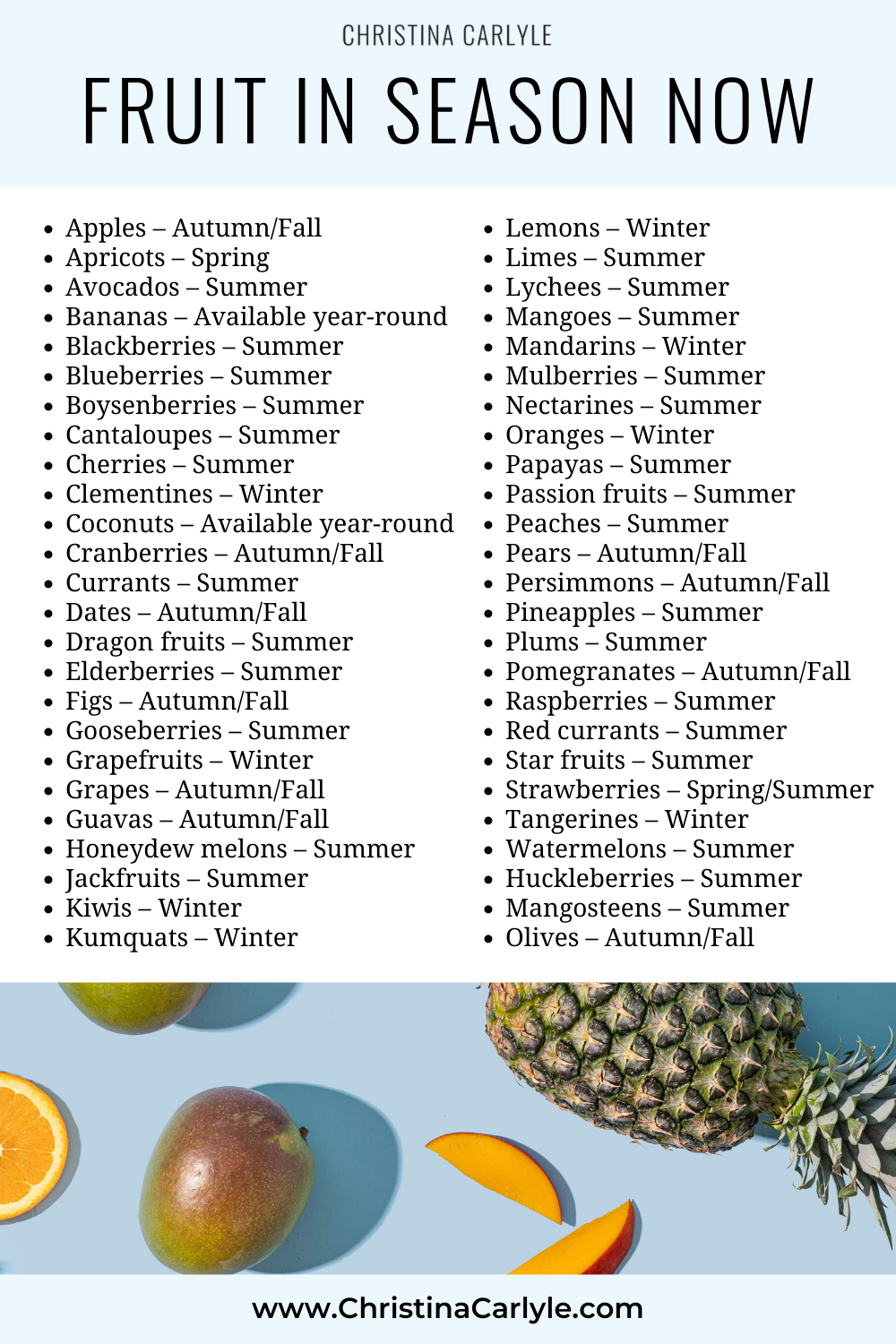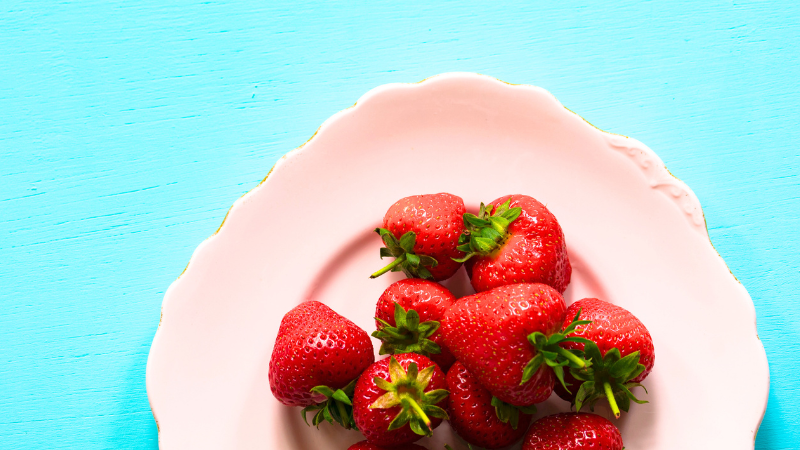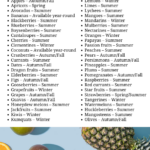Last Updated on October 26, 2023
It’s best to eat a fruit in season to get the maximum flavor, texture, and highest nutrient content… this is especially true if you’re concerned about consuming fruit for weight loss or health.
So first I’m going to share the 50 most common fruits and when they’re in season, a list of planting and harvesting seasons, planting tips to grow your own fruits seasonally, and recipes to enjoy your seasonal fruit.
Why You Should Eat Fruits Seasonally
Eating fruit in season has several benefits, both for individuals and the environment, including,
- Better flavor and quality: Fruits that are in season are typically harvested at their peak ripeness. This means they are more flavorful, juicier, and have better texture compared to fruits that are harvested prematurely or stored for a long time. Eating fruit in season allows you to enjoy their natural taste and aroma to the fullest.
- Higher nutritional value: Freshly harvested, in-season fruits tend to have higher nutritional content. As fruits ripen on the plant, they accumulate more vitamins, minerals, antioxidants, and phytochemicals, which are beneficial for our health. By consuming fruits when they are in season, you can maximize the nutritional benefits they provide.
- Cost-effectiveness: When fruits are in season, they are generally more abundant and locally available. This increased supply often leads to lower prices, making them more affordable for consumers. Out-of-season fruits, on the other hand, may need to be imported from distant locations or grown in controlled environments, which can result in higher prices.
- Support for local agriculture: Choosing to eat fruit in season supports local farmers and the agricultural economy. By purchasing fruits that are locally grown and in season, you contribute to the sustainability of local food systems, reduce transportation distances, and support the livelihoods of farmers in your community.
- Environmental benefits: Eating fruit in season can have positive environmental impacts. Locally grown, seasonal fruits often require less transportation and refrigeration, reducing greenhouse gas emissions associated with long-distance transport and storage. Additionally, growing fruits in their natural season reduces the need for artificial methods such as heated greenhouses, which can consume significant energy resources.
- Variety and connection to nature: Eating fruit in season allows you to enjoy a diverse range of flavors and textures throughout the year. It reconnects you with the natural rhythms of the seasons and helps you appreciate the cyclical nature of agricultural production. By embracing seasonal eating, you can explore different fruits as they come into season, expanding your culinary experiences.
While it’s not always possible to eat exclusively in-season fruits, incorporating them into your diet when available can provide numerous benefits.
Enjoying fruits at their peak freshness not only enhances your eating experience but also supports local agriculture and promotes sustainable food choices, too. The more brightly colored a fruit’s skin, the more benefits it’ll have.
Here’s a list of the top 50 Fruits and when they’re in season. After you’re done taking a look, leave me a comment and let me know which fruit you’re most excited to eat this season.
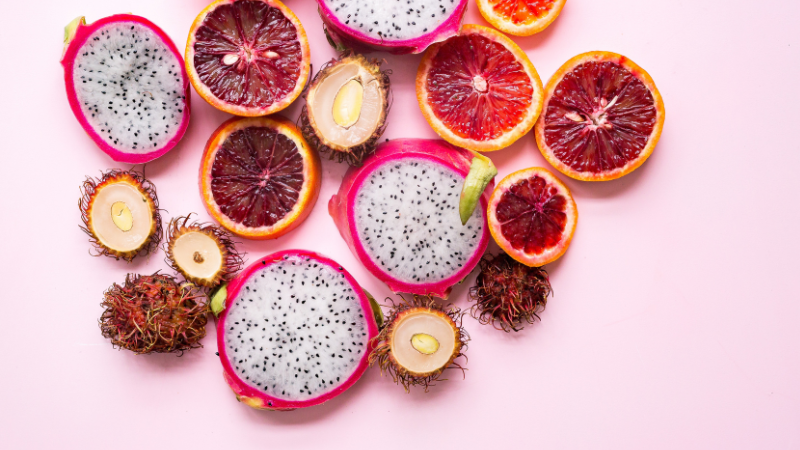
Fruits in Season Now
- Apples – Autumn/Fall
- Apricots – Spring
- Avocados – Summer
- Bananas – Available year-round
- Blackberries – Summer
- Blueberries – Summer
- Boysenberries – Summer
- Cantaloupes – Summer
- Cherries – Summer
- Clementines – Winter
- Coconuts – Available year-round
- Cranberries – Autumn/Fall
- Currants – Summer
- Dates – Autumn/Fall
- Dragon fruits – Summer
- Elderberries – Summer
- Figs – Autumn/Fall
- Gooseberries – Summer
- Grapefruits – Winter
- Grapes – Autumn/Fall
- Guavas – Autumn/Fall
- Honeydew melons – Summer
- Jackfruits – Summer
- Kiwis – Winter
- Kumquats – Winter
- Lemons – Winter
- Limes – Summer
- Lychees – Summer
- Mangoes – Summer
- Mandarins – Winter
- Mulberries – Summer
- Nectarines – Summer
- Oranges – Winter
- Papayas – Summer
- Passion fruits – Summer
- Peaches – Summer
- Pears – Autumn/Fall
- Persimmons – Autumn/Fall
- Pineapples – Summer
- Plums – Summer
- Pomegranates – Autumn/Fall
- Raspberries – Summer
- Red currants – Summer
- Star fruits – Summer
- Strawberries – Spring/Summer
- Tangerines – Winter
- Watermelons – Summer
- Huckleberries – Summer
- Mangosteens – Summer
- Olives – Autumn/Fall
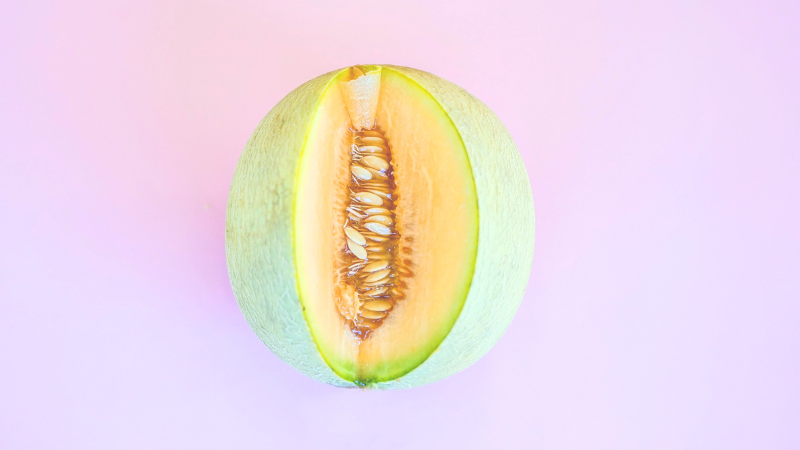
Fruit Planting and Harvesting Season
Planting your own fruit is a great way to ensure you’ll have some in season. Below is a list of planting and harvest season so you’ll know when to plant fruits year round to maximize health benefits.
- Apples – Plant in early Spring; best to eat in late Summer to early Autumn.
- Apricots – Plant in early Spring; best to eat in early Summer.
- Avocados – Plant in Spring or Autumn; best to eat in Winter.
- Bananas – Plant in Spring; can be eaten throughout the year (depending on the variety and climate).
- Blackberries – Plant in early Spring; best to eat in Summer.
- Blueberries – Plant in Spring; best to eat in Summer.
- Cherries – Plant in late Winter to early Spring; best to eat in late Spring to early Summer.
- Cranberries – Plant in Spring; best to eat in Autumn.
- Figs – Plant in late Winter to early Spring; best to eat in late Summer to early Autumn.
- Grapes – Plant in early Spring; best to eat in Autumn.
- Kiwis – Plant in Spring or Autumn; best to eat in late Autumn.
- Lemons – Plant in Spring; can be eaten throughout the year (depending on the variety and climate).
- Limes – Plant in Spring; can be eaten throughout the year (depending on the variety and climate).
- Mangoes – Plant in late Winter to early Spring; best to eat in Summer.
- Oranges – Plant in Spring; best to eat in Winter.
- Papayas – Plant in Spring; best to eat in Summer.
- Passion fruits – Plant in Spring; best to eat in late Summer to early Autumn.
- Peaches – Plant in late Winter to early Spring; best to eat in Summer.
- Pears – Plant in late Winter to early Spring; best to eat in Autumn.
- Pineapples – Plant in Spring; best to eat in Summer.
- Plums – Plant in late Winter to early Spring; best to eat in Summer.
- Pomegranates – Plant in early Spring; best to eat in Autumn.
- Raspberries – Plant in early Spring; best to eat in Summer.
- Strawberries – Plant in early Spring; best to eat in late Spring to early Summer.
- Watermelons – Plant in late Spring; best to eat in Summer.
- Cantaloupes – Plant in late Spring; best to eat in Summer.
- Honeydew melons – Plant in late Spring; best to eat in Summer.
- Nectarines – Plant in late Winter to early Spring; best to eat in Summer.
- Persimmons – Plant in early Spring; best to eat in Autumn.
- Guavas – Plant in early Spring; best to eat in Autumn.
- Dates – Plant in Spring; best to eat in Autumn.
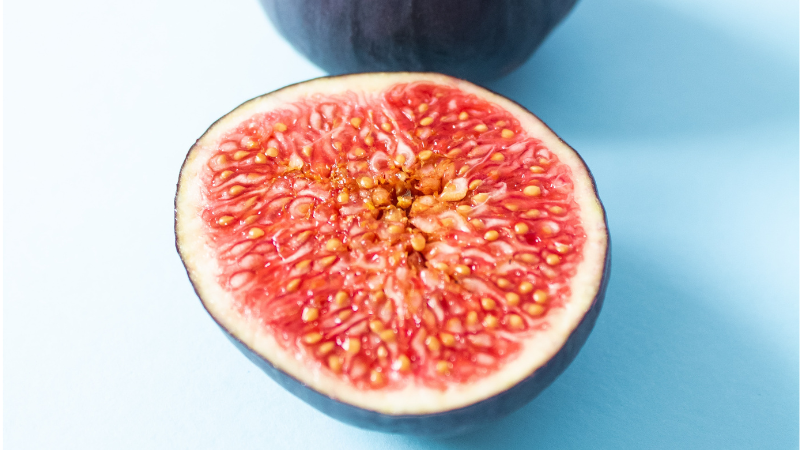
Planting Tips to Yield the Most Fruit
Planting fruit seeds, bushes, and trees can be a rewarding experience. Personally, I find growing my own food therapeutic.
Here are some tips I recommend to help you get started growing your own fruits in season:
- Choose the right location: Select a spot that receives adequate sunlight and has well-drained soil suitable for the specific fruit variety you want to plant.
- Prepare the soil: Before planting, ensure that the soil is well-prepared. Remove any weeds, rocks, or debris, and loosen the soil to a depth of at least 12 inches. You can also add compost or organic matter to improve the soil’s fertility and drainage.
- Follow planting instructions: Different fruits have varying planting requirements, so it’s essential to follow specific instructions for each type. Some fruits, like berries, can be planted directly in the ground, while others may require starting indoors or in containers.
- Planting seeds: If you are planting fruit seeds, such as those from apples, peaches, or citrus fruits, you’ll need to germinate them first. Place the seeds in a damp paper towel or soak them in water overnight to encourage germination. Then, plant the germinated seeds at the recommended depth in the soil.
- Planting bushes: For fruit bushes, such as blueberries or raspberries, dig a hole that is wide and deep enough to accommodate the roots. Place the bush in the hole and backfill with soil, gently firming it around the roots. Ensure that the bush is planted at the appropriate depth, with the root collar level with or slightly above the soil surface.
- Planting trees: When planting fruit trees, dig a hole that is wider and deeper than the root system. Place the tree in the hole, making sure the root collar (the swollen area where the trunk meets the roots) is level with the soil surface. Backfill the hole with soil, gently firming it around the roots. Consider staking the tree for support, if necessary.
- Watering: After planting, water the newly planted seeds, bushes, or trees thoroughly to settle the soil and establish good root contact. Monitor the moisture levels and water regularly, especially during dry periods, but avoid overwatering, as it can lead to root rot.
- Pruning and maintenance: Follow proper pruning techniques for your specific fruit variety to promote healthy growth and fruit production. Regularly remove any dead, damaged, or diseased branches. Mulching around the base of the plants or trees can help conserve moisture, suppress weeds, and regulate soil temperature.
- Pest and disease control: Monitor your fruit plants for any signs of pests or diseases. Take preventive measures such as using organic pest control methods, installing physical barriers, or employing beneficial insects to manage pests effectively.
- Patience and care: Growing fruit from seeds, bushes, or trees requires patience. It takes time for the plants to mature and produce a bountiful harvest. Be consistent with your care routine, including regular watering, fertilizing as needed, and providing proper protection from harsh weather conditions.
Remember, specific fruits may have unique requirements, so research variety-specific guides or gardening resources to get more detailed instructions.
Enjoying Fruit in Season
I recommend eating fruits in season and also rotating them throughout seasons. Eating this way helps you maximize nutrient intake, flavor, and health benefits.
Here are some ideas to start enjoying fruit more seasonally:
- Fresh, Raw or Frozen: Enjoy the fruits as they are, fresh and raw. Wash them, slice them, and savor their natural flavors. Eating a ripe juicy peach, biting into a crisp apple, or indulging in a handful of berries can be a simple and satisfying experience.
- Fruit Salad: Create a vibrant and refreshing fruit salad by combining different seasonal fruits. Mix together chunks of watermelon, pineapple, grapes, berries, and any other fruits you enjoy. Add a squeeze of lemon or lime juice for an extra zing, or drizzle with a bit of honey for sweetness.
- Smoothies: Blend your favorite seasonal fruits with yogurt or plant-based milk to make delicious and nutritious smoothies. You can experiment with different combinations and add-ons like spinach, banana, chia seeds, or nut butter for added flavor and texture. I recommend washing, prepping (peeling/cutting) your fruit, then freezing it to use in smoothies. Freezing fruit helps gives smoothies creamier consistency and more flavor compared to smoothies made with blended ice.
- Grilled or Roasted: Take advantage of grilling or roasting fruits to enhance their natural sweetness and create a unique flavor profile. Grilled peaches, roasted plums, or caramelized pineapple can be fantastic additions to salads, desserts, or even savory dishes.
- Fruit Salsa: Create a flavorful fruit salsa by chopping up seasonal fruits like mango, kiwi, strawberries, and citrus. Add some diced onion, jalapeño, cilantro, lime juice, and a pinch of salt for a delightful topping for grilled fish, tacos, or as a dip with tortilla chips.
- Fruit Parfaits: Layer seasonal fruits with yogurt or whipped cream in a glass to create a visually appealing and delicious fruit parfait. Top with granola, nuts, or a drizzle of honey for added crunch and sweetness.
Easy, Yummy Fruit Recipes
Here are some fruit recipes to try:
I hope this inspired you. Leave me a comment and let me know what fruits are in season that you’ll be eating.
Sign up for my newsletter below so you won’t miss my next posts.
xo
Your Coach and Biggest Cheerleader,
![]()
If you liked this post, you’ll love The Best Fruits for Weight Loss
Pin this list of fruits in season to Pinterest so you’ll have it forever.
